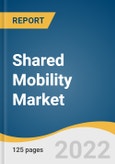The global shared mobility market size is expected to reach USD 731.5 billion by 2030. The market is anticipated to register a CAGR of 16.9% from 2022 to 2030. Rising Internet penetration and increased investment in shared mobility applications are the major factors driving the market. With a rise in smart mobility, which is a revolutionary way of figuring out ways to commute in safe, clean, and efficient mode, basically find out a way of Zero-emission, Zero ownership, and Zero accidents. Furthermore, due to the continued development in the use of AI, the market has risen significantly over the last two decades and will continue to grow in the coming years.
Additionally, in terms of commuting time, contactless payment, and overall efficiency, the public transportation system has improved significantly over the last few decades. Many recent developments in technology start-ups have occurred as a result of an increase in market prospects. Market players are increasingly coming up with new motorbike or cab sharing strategies. The public sector is getting even smarter by focusing on routes of public buses and being concerned about timings, as shown by the tracking monitor of different public vehicles at a bus stop. Investors now have started investing in abundance in such a concept seeing the potential market’s future. In recent years, shared mobility has taken a keen interest in becoming smarter, as Electric vehicles (EVs) have begun to enter the market, offering it more cost-effective, environmentally friendly, and comfortable.
Moreover, several companies have started making mobile apps to support working toward non-ownership rides. In such a module, the rider can book their ride as per their requirement, route, time, and type of vehicle without owning rather than renting the vehicle for that particular time frame. Ridesharing is growing at the highest rate during the forecast period, and this can be due to customers' wide adoption of the cost-effective and elegant mode of transport rides. In addition, clients who had previously rented a driver to drive their vehicle owing to its cost-effectiveness have now started to shift to shared transportation. Key factors driving the growth of the market globally include increased consumer awareness about shared mobility applications and systems, and higher reliance on mobile applications to make daily processes easier.
This product will be delivered within 1-3 business days.
Additionally, in terms of commuting time, contactless payment, and overall efficiency, the public transportation system has improved significantly over the last few decades. Many recent developments in technology start-ups have occurred as a result of an increase in market prospects. Market players are increasingly coming up with new motorbike or cab sharing strategies. The public sector is getting even smarter by focusing on routes of public buses and being concerned about timings, as shown by the tracking monitor of different public vehicles at a bus stop. Investors now have started investing in abundance in such a concept seeing the potential market’s future. In recent years, shared mobility has taken a keen interest in becoming smarter, as Electric vehicles (EVs) have begun to enter the market, offering it more cost-effective, environmentally friendly, and comfortable.
Moreover, several companies have started making mobile apps to support working toward non-ownership rides. In such a module, the rider can book their ride as per their requirement, route, time, and type of vehicle without owning rather than renting the vehicle for that particular time frame. Ridesharing is growing at the highest rate during the forecast period, and this can be due to customers' wide adoption of the cost-effective and elegant mode of transport rides. In addition, clients who had previously rented a driver to drive their vehicle owing to its cost-effectiveness have now started to shift to shared transportation. Key factors driving the growth of the market globally include increased consumer awareness about shared mobility applications and systems, and higher reliance on mobile applications to make daily processes easier.
Shared Mobility Market Report Highlights
- The market is being driven by shared mobility convenience. Growing usage of shared mobility in the peer-to-peer car sharing segment will propel the overall market during the forecast period.
- The bike sharing segment is expected to witness the highest CAGR of 20.3% during the forecast period. This is attributed to an increase in the number of bike sharing schemes, particularly in developed countries around the world.
- In Asia Pacific, the market accounted for the largest revenue share of 24.7% in 2021.
- In Middle East and Africa, the market is expected to witness a significant CAGR of 18.4% during the forecast period, owing to the advancements in technology.
This product will be delivered within 1-3 business days.
Table of Contents
Chapter 1 Methodology and Scope
Chapter 2 Executive Summary
Chapter 3 Shared Mobility Market Variables, Trends, and Scope
Chapter 4 Shared Mobility Service Model Estimates & Trend Analysis
Chapter 5 Shared Mobility Vehicle Estimates & Trend Analysis
Chapter 6 Shared Mobility Regional Estimates & Trend Analysis
Chapter 7 Competitive Landscape
Companies Mentioned
- Car2Go
- Deutsche Bahn Connect GmbH
- Didi Chuxing
- Drive Now (Bmw)
- Evcard
- Flinkster
- Grab
- Greengo
- Lyft
- Uber
- Zipcar
Methodology

LOADING...
Table Information
| Report Attribute | Details |
|---|---|
| No. of Pages | 125 |
| Published | April 2022 |
| Forecast Period | 2022 - 2030 |
| Estimated Market Value ( USD | $ 209.4 Billion |
| Forecasted Market Value ( USD | $ 731.5 Billion |
| Compound Annual Growth Rate | 16.9% |
| Regions Covered | Global |
| No. of Companies Mentioned | 11 |









